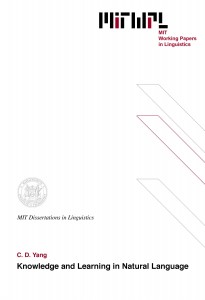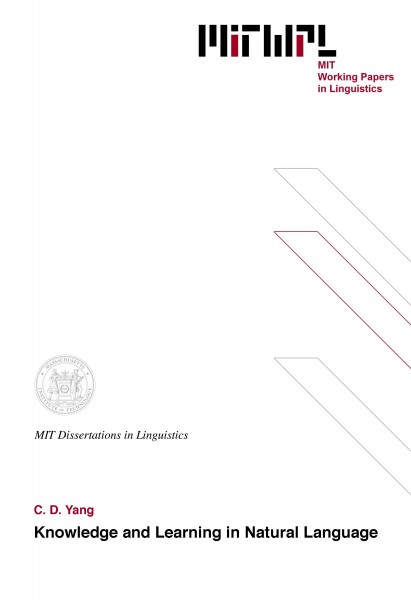Knowledge and Learning in Natural Language
C. D. Yang, 2000
This present disseration is a study of language development in children. From a biological perspective, the development of language, as the development of any other organic system, is an interaction between internal and external factors; specifically, between the child’s internal knowledge of linguistic structures and the external linguistic experience he receives. Drawing insights from the study of biological evolution, we put forth a quantitative model of language acquisition that make this interaction precise, by embedding a theory of knowledge, the Universal Grammar, into a theory of learning from experience. In particular, we advance the idea that language acquisition should be modeled as a population of grammatical hypotheses, competing to match the external linguistic experiences, much like in a natural selection process. We present evidence – conceptual, mathematical, and empirical, and from a number of independent areas of linguistic research, including the acquisition of syntax and morphology, and historical language change – demonstrate the model’s correctness and utility.
Thesis supervisors: Robert C. Berwick, Noam Chomsky
Titles: Professor of Computer Science and Brain and Cognitive Science,
Institute Professor of Linguistics and Philosophy
Table of Contents
1 The study of language and language acquisition 10
1.1 The naturalistic approach to language 10
1.2 The structure of language acquisition 13
1.2.1 Formal sufficiency 14
1.2.2 Development compatibility 15
1.2.3 Explanatory continuity 17
1.3 A roadmap 20
2 A variational model of language acquisition 21
2.1 Against transformational learning 22
2.1.1 Formal insufficiency of the triggering model 25
2.1.2 Developmental incompatibility of the triggering model 26
2.1.3 Imperfection in child language? 28
2.2 The variational approach to language acquisition 30
2.2.1 The dynamics of Darwinian evolution 30
2.2.2 Language acquisition as grammar competition 31
2.3 The dynamics of variational learning 35
2.3.1 Asymptotic behaviors 35
2.3.2 Stable multiple grammars 37
2.3.3 Unambiguous evidence 39
2.4 Learning grammars in a parametric space 41
2.4.1 Parameters make learning efficient 41
2.4.2 Parameter expression and cues 45
2.5 Related approaches 46
3 Competing grammars in child syntax 49
3.1 The development of three parameters 50
3.1.1 Verb raising and subject drop: the baselines 51
3.1.2 V1 patterns in V2 learners 52
3.2 A quantitative argument from the poverty of the stimulus 55
3.3 The nature of null subjects in children 60
3.3.1 The early acquisition of Chinese and Italian subject drop 62
3.3.2 Why English kids (sometimes) use Chinese 63
3.4 Summary 66
4 Words, rules, and competitions 68
4.1 Background 68
4.2 A model of rule competition 71
4.2.1 A simple learning task 72
4.2.2 Rules 73
4.2.3 Rule competition 76
4.2.4 The absolute and stochastic blocking principles 81
4.3 Words vs. rules in overregularization 82
4.3.1 The mechanics of the WR model 83
4.3.2 The data 85
4.3.3 Frequency hierarchy in verb classes 86
4.3.4 The free-rider effect 89
4.3.5 The effect of phonological regularity; vowel shortening 91
4.4 Analogy, regularity, and rules 92
4.4.1 Analogies or rules 92
4.4.2 Partial regularity and history 96
4.5 Some purported evidence for the WR model 98
4.5.1 Error rate 98
4.5.2 The role of input frequency 100
4.5.3 The postulation of the –d rule 101
4.5.4 Gradual improvement 103
4.5.5 Children’s judgment 104
4.5.6 Anecdotal evidence 105
4.5.7 Adult overregularization 105
4.5.8 Indecisive verbs 106
4.5.9 Irregulars over time 106
4.5.10 Corpus statistics 106
4.6 Conclusion 106
5 Internal and external forces in language change 111
5.1 Grammar competition and language change 113
5.1.1 The role of linguistic evidence 113
5.1.2 A variational model of language change 115
5.2 The loss of V2 in French 119
5.3 The erosion of V2 in Middle English 123
5.3.1 Word order in Old English 123
5.3.2 The southern dialect 125
5.3.3 The northern dialect and language contact 126
5.4 Conclusion 128
6 A synthesis of linguistic knowledge and learning 129

